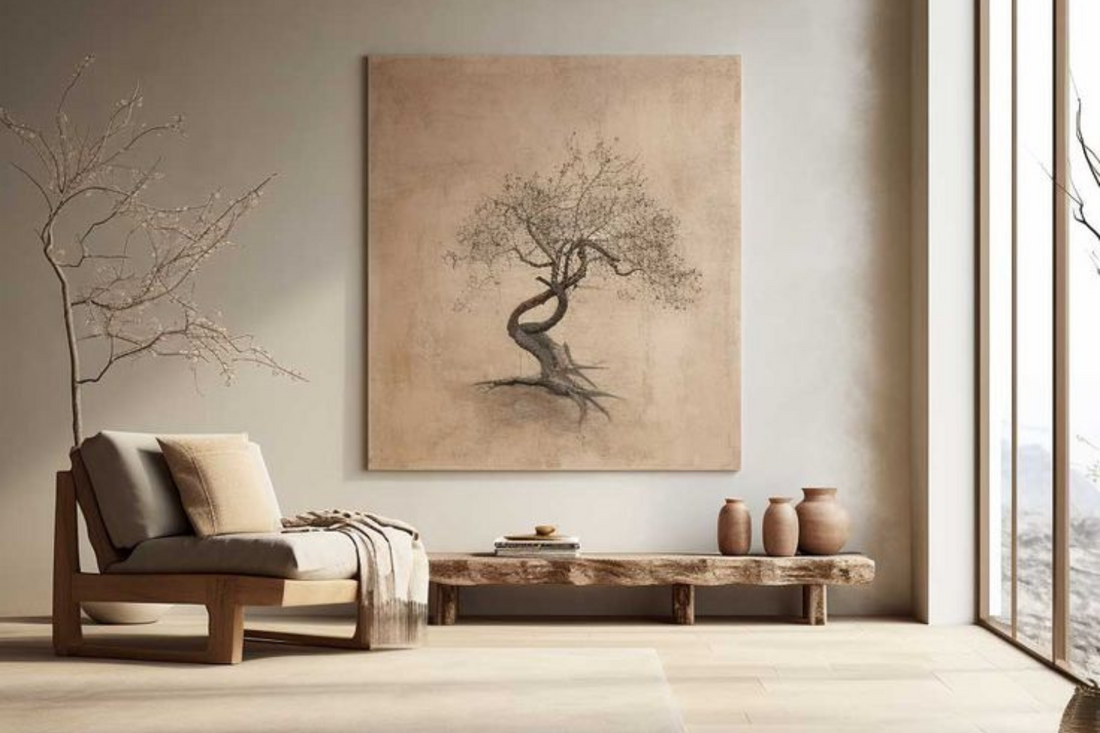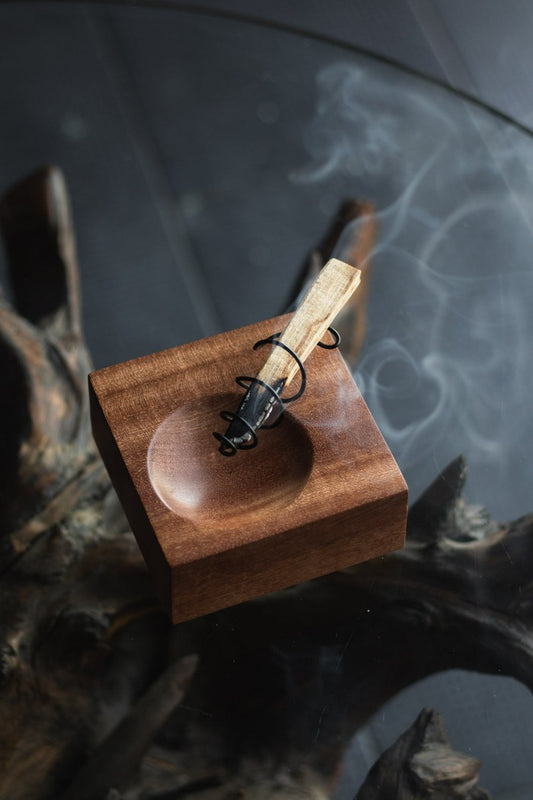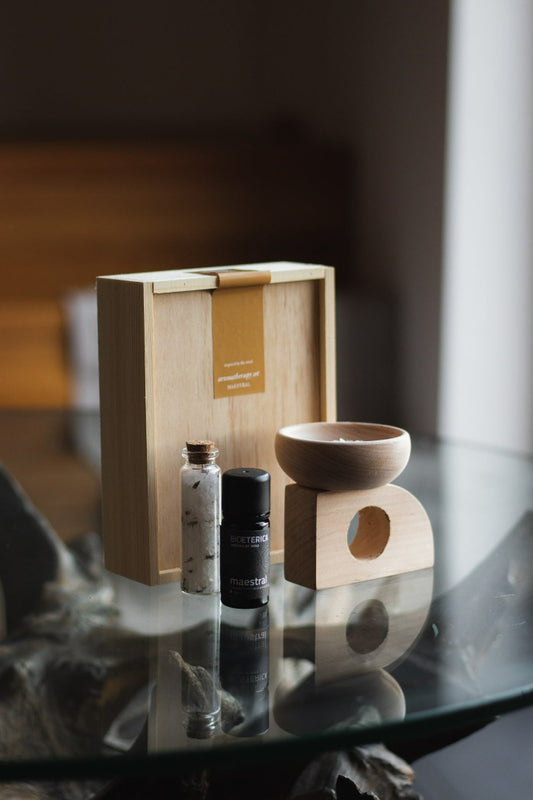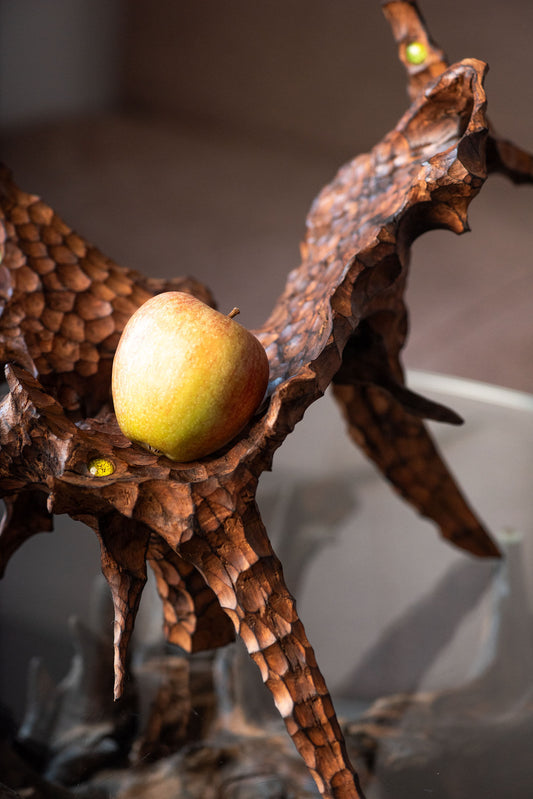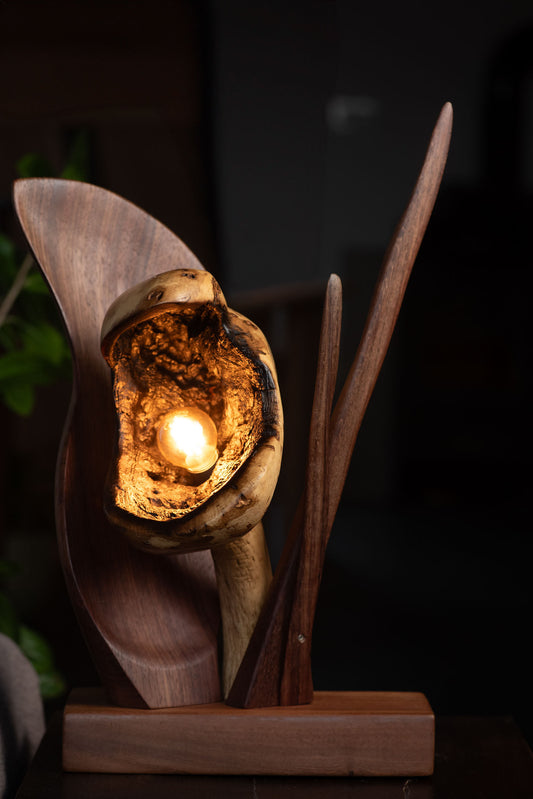In a world that often values perfection and precision, the Japanese aesthetic of Wabi Sabi offers a refreshing perspective. Rooted in the acceptance of impermanence and imperfection, it celebrates the beauty of the imperfect, impermanent, and incomplete. This ancient philosophy has found its way into various aspects of design, from interiors to fashion, providing a serene and harmonious ambiance.
Wabi Sabi isn't just a design aesthetic; it's also a lifestyle philosophy that permeates various aspects of daily life. At its core, this beautiful lifestyle encourages a mindful, simple, and appreciative approach to living that embraces imperfection, impermanence, and the beauty of the natural world.
The key to successful Wabi Sabi design or lifestyle is understanding its principles. Only then, we can see the big picture and start to visualise our desired interiors. So first, let’s dive into the most important principals of Wabi Sabi.
The Key Principles of Wabi Sabi
Wabi Sabi is a Japanese aesthetic philosophy that originated from Buddhist teachings and ancient Japanese tea ceremonies, particularly from the teachings of Sen no Rikyu, a Japanese tea master from the 16th century. It embodies a worldview centered around the acceptance of imperfection, impermanence, and the beauty of the natural world.
So let’s see what are the key principles of Wabi Sabi:
Kanso – Simplicity
"Kanso" is a Japanese term that translates to "simplicity" or "elimination of clutter." It is considered one of the key principles of Wabi Sabi, emphasising the beauty and elegance found in simplicity, minimalism, and the elimination of the unnecessary.
Kanso encourages us to pare down our surroundings to their essential elements, removing excess ornamentation, decoration, and clutter. It invites us to create spaces that are uncluttered, harmonious, and conducive to a sense of calmness and tranquility.
Kanso is closely related to the concept of "shibui," which refers to a subtle and restrained aesthetic that values understatement and refinement. Together, these principles encourage us to appreciate the beauty of simplicity and to find joy in the unadorned and unembellished.
In daily life, Kanso encourages us to simplify our surroundings and routines, reducing the distractions and complications that can clutter our lives. It invites us to focus on what truly matters, letting go of excess and embracing a more minimalist and intentional way of living.
Overall, Kanso reminds us of the beauty and elegance found in simplicity. By embracing simplicity and eliminating clutter, we can create spaces that are both aesthetically pleasing and conducive to a sense of peace and harmony.
Funkinsei -Asymmetry
"Fukinsei" is a term in Japanese aesthetics that refers to asymmetry or irregularity. Fukinsei celebrates the beauty of asymmetry and irregularity in both natural and human-made objects.
Rather than adhering to rigid symmetry or perfect balance, Fukinsei embraces the idea that beauty can be found in asymmetrical arrangements and irregular shapes.This principle is deeply rooted in the observation of nature, where symmetry is often rare and imperfections are abundant. For example, a gnarled tree trunk, a cluster of rocks, or the irregular petals of a flower all exhibit Fukinsei in their natural form.
Fukinsei reminds us that perfection is not necessary for beauty and that embracing asymmetry and irregularity can lead to more dynamic, engaging, and authentic expressions of art and design. It encourages us to appreciate the inherent beauty of imperfection and to find harmony in the natural variations and irregularities of the world around us.
Shibumi – Beauty In The Understated
Shibumi is a concept that originates from the Japanese culture of elegance and refinement. While it's not traditionally considered one of the core principles of Wabi Sabi, Shibumi shares similar ideals of simplicity, understated beauty, and authenticity.
Shibumi can be described as a quality of effortless elegance, subtle refinement, and quiet sophistication. It embodies a sense of naturalness and spontaneity, devoid of unnecessary embellishments or ostentation. The term "Shibumi" is often used to describe objects, experiences, or actions that possess a certain understated charm and grace.
Shibumi can be seen as an expression of the beauty of simplicity and the appreciation of the inherent elegance found in everyday life. It emphasises the idea that true beauty lies in simplicity, authenticity, and a deep connection to the natural world.
For example, a simple handcrafted ceramic bowl with subtle imperfections and a weathered patina could be considered Shibumi. Its beauty lies not in ornate decoration or flashy design, but in its understated elegance and quiet presence. Similarly, a serene landscape, a quiet moment of contemplation, or a perfectly imperfect arrangement of flowers can embody the essence of Shibumi.
Shizen – Naturalness
"Shizen" is a Japanese term that translates to "naturalness" or "authenticity." It is one of the fundamental principles of Wabi Sabi, emphasising the beauty and authenticity found in nature and the natural world.
Shizen encourages us to appreciate the inherent beauty of the natural world and to seek authenticity in all aspects of life. It emphasises simplicity, harmony, and a deep connection to nature, reminding us to embrace the imperfections and irregularities that characterise the natural world.
Shizen is closely related to the concept of "kanso," which emphasises simplicity and elimination of the unnecessary. Together, these principles encourage us to strip away excess and artificiality, allowing the true essence of objects and experiences to shine through.
In daily life, Shizen invites us to slow down, observe our surroundings, and cultivate a deeper connection to nature. It encourages us to find moments of peace and tranquility in natural settings, whether it's a walk in the woods, a stroll along the beach, or simply gazing at the stars on a clear night.
Yugen – Subtle Grace
"Yūgen" is a Japanese term that is closely associated with Wabi Sabi aesthetics, although it may not always be explicitly listed among its core principles. Yūgen can be challenging to translate directly into English, but it generally refers to a profound sense of mystery, depth, and beauty that is hinted at or suggested rather than fully revealed.
Yūgen is often used to describe the ineffable beauty and transcendent quality found in objects, experiences, or moments that evoke a sense of wonder, awe, and reverence. It invites us to contemplate the mysterious and unknowable aspects of existence and to find beauty in the subtle nuances and hidden depths of the world around us.
Yūgen encourages us to embrace ambiguity, uncertainty, and the unknown, recognising that true beauty often lies beyond the surface and cannot be fully captured or explained. It invites us to engage with the world with a sense of curiosity, openness, and wonder, allowing ourselves to be captivated by the mysteries of life.
In art and design, Yūgen inspires artists and craftsmen to create works that invite contemplation and reflection, drawing viewers into a deeper exploration of meaning and beauty. It encourages the use of suggestive imagery, subtle symbolism, and evocative metaphors to evoke a sense of Yūgen and invite viewers to connect with the deeper layers of meaning within the work.
In daily life, Yūgen encourages us to cultivate a sense of mindfulness and presence, allowing ourselves to fully immerse in the richness and complexity of each moment. It invites us to embrace the beauty of the unknown and to find joy and wonder in the ordinary and mundane aspects of life.
Overall, Yūgen reminds us of the vastness and mystery of the universe and encourages us to approach life with a sense of wonder, curiosity, and reverence. By embracing ambiguity, uncertainty, and the unknown, we can open ourselves up to new possibilities, experiences, and ways of being.
Datsuzoku – Freedom From Habits
"Datsuzoku" is a Japanese term that translates to "freedom from habit" or “unconventionality." Datsuzoku encourages a departure from conventional norms and expectations, embracing spontaneity, creativity, and a sense of freedom in both artistic expression and daily life. It invites us to break free from rigid routines, societal conventions, and preconceived notions of beauty, allowing for greater authenticity, individuality, and innovation.
Datsuzoku encourages us to embrace the beauty of impermanence and change, recognising that life is inherently unpredictable and that beauty often lies in the unexpected and unconventional. It invites us to approach each moment with a sense of openness, curiosity, and willingness to explore new possibilities.
In daily life, Datsuzoku encourages us to break free from the constraints of conformity and embrace our unique individuality. It invites us to follow our own passions, interests, and desires, rather than adhering to societal norms or expectations. Datsuzoku reminds us that true freedom comes from living authentically and embracing the richness and diversity of life.
Seijaku – Tranquility
"Seijaku" is a Japanese term that can be translated as "tranquility" or "stillness." It is one of the key principles of Wabi Sabi, representing a state of calmness, serenity, and inner peace.
Seijaku encourages us to cultivate a sense of quietude and inner harmony amidst the busyness and chaos of the world around us. It invites us to slow down, quiet the mind, and find moments of stillness and reflection in our daily lives.
Seijaku is closely related to the concept of "ma," which refers to the space between objects or the pause between musical notes. It emphasizes the importance of creating moments of pause and silence, allowing for contemplation, introspection, and appreciation of the present moment.
In art and design, Seijaku inspires artists and craftsmen to create works that evoke a sense of tranquility and serenity. It encourages the use of minimalist aesthetics, uncluttered spaces, and subtle forms to create an atmosphere of calmness and stillness.
In daily life, Seijaku encourages us to seek out moments of quiet contemplation and reflection. Whether it's through meditation, mindfulness practices, or simply spending time in nature, Seijaku invites us to connect with our inner selves and find peace amidst the hustle and bustle of modern life.
10 tips for Wabi Sabi Interior Design
If you're looking to infuse your living spaces with the tranquil essence of Wabi Sabi, here are ten tips to get you started:
-
Embrace Imperfection:
At the heart of Wabi Sabi design is the acceptance of imperfection. Rather than striving for flawlessness, embrace the beauty of natural wear and tear, irregular shapes, and asymmetry. Incorporate elements like handcrafted pottery with visible cracks or weathered wooden furniture to add character and depth to your space.
-
Simplify:
Wabi Sabi design favours simplicity and minimalism. Opt for clean lines, uncluttered spaces, and natural materials to create a sense of calm and tranquility. Choose furnishings and decor items that serve a purpose and avoid excess ornamentation.
-
Use Natural Materials:
Incorporate natural materials such as wood, stone, bamboo, and linen into your design scheme. These materials not only evoke a sense of warmth and authenticity but also age gracefully, developing a patina over time that adds to their charm.
-
Create Neutral Color Palette:
A muted and earthy color palette is characteristic of Wabi Sabi design. Choose colors inspired by nature, such as soft greens, warm browns, and muted grays, to create a serene and harmonious atmosphere. Embrace the beauty of subtle variations in hue and tone.
-
Play with Imperfect Textures:
Textures play a crucial role in Wabi Sabi design, adding depth and tactile appeal to your space. Incorporate rough-hewn surfaces, natural textiles, and handmade ceramics to introduce a sense of tactility and visual interest. Embrace the beauty of imperfections like irregularities in weave or rough edges.
-
Integrate Nature: Bring the outdoors in by incorporating elements of nature into your design. Display branches, stones, or dried flowers in simple vases, or introduce indoor plants to infuse your space with life and vitality. Create connections to the natural world to cultivate a sense of harmony and balance.
-
Celebrate Patina and Age:
Embrace the concept of wabi-sabi by celebrating the beauty of objects that bear the marks of time and use. Choose vintage or antique pieces with a sense of history and character, appreciating the stories they carry with them. Allow objects to age gracefully, cherishing the beauty that comes with time.
-
Choose Handcrafted Artistry:
Support artisans and craftsmen by incorporating handcrafted items into your design scheme. Choose pieces that showcase the skill and artistry of their makers, whether it's a hand-thrown ceramic vase or a handwoven textile. Celebrate the human touch and the unique imperfections that make each piece one-of-a-kind.
-
Apply Mindful Placement:
Consider the placement of objects within your space with mindfulness and intention. Create compositions that are balanced yet dynamic, allowing for visual interest and flow. Embrace the concept of ma, or negative space, to create moments of pause and reflection within your environment.
-
Appreciate the Moment:
Finally, embrace the philosophy of Wabi Sabi by cultivating an appreciation for the beauty of the present moment. Take the time to notice and savour the simple joys and fleeting moments that surround you. Allow your living space to serve as a sanctuary, reminding you to slow down, breathe, and find beauty in the everyday.
Wabi Sabi offers a profound philosophy for living that encourages us to embrace imperfection, simplicity, and the inherent beauty of the natural world. By incorporating these principles into our lives and surroundings, we can create spaces that nurture the soul, foster a sense of peace and tranquility, and remind us of the richness and beauty of life itself.
Incorporating these principles into your design aesthetic can transform your living spaces into havens of tranquility and beauty. By embracing imperfection, simplicity, and the inherent beauty of natural materials, you can create a home that nourishes the soul and fosters a sense of peace and harmony amidst the chaos of modern life. So, why not embark on a journey of Wabi Sabi design and discover the timeless beauty of imperfection?

